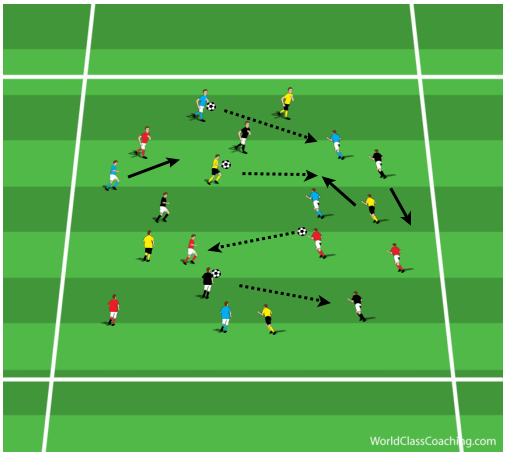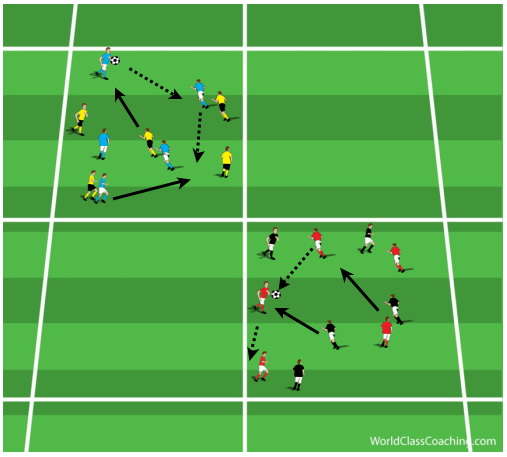By Sean Reed -
Objective
These sessions can used as part of the warm-up and they aimed to engage the players leading into the session. They will focus on their awareness, decision-making, and movement to create an option, along with specific types of football movements.
These types of sessions can be used with any age, any level and developed in anyway in order to challenge your players. Furthermore, you can set them up as multi directional games, directional games, games with a specific playing shape (all discussed within future sessions)
Session 1

Diagram 1
Set Up
- For the number displayed in the diagram, split the group into 4 teams (5v5) See diagram 1. Each Team will have one ball and begin passing the ball within their teams using their hands.
- They can only play to their own team. If there is no immediate option they must stay on the ball but keep moving. Encouraging them to accelerate into space
- Once they play the pass you can then ask them to focus on a specific types of movement for example, backwards movement, sideways, jump up, onto the ground then get up, change of pace with the movement (all specific to what the game demands). It is an opportunity for the coach to be creative and also encourage the players to be creative and take a lead with the movements required to perform.
- It is important that the coach encourages the players to work round the other teams and use them to create angles to receive, run past, play 1-2’s round etc
Examples of ways to progress the session in order to challenge the players
- Encourage players to think of different ways to pass the ball
- The players cannot play a pass that is overhead height. They have the option to play a bounce pass
- Player can play a pass with either a header or volley by serving to themselves
- As above, but allow the ball to bounce before playing the pass
- When a player receives the ball they can catch it and must make a movement within a different direction (take the ball off line)
- A player must receive the ball by controlling it before using their hands
Change the size of area to challenge their movement, spatial awareness and the time they have on the ball
These are just a few examples of how the coach can change it up to stimulate and challenge the players
Coaching Points
- Awareness before receiving the ball
- Angles and body shape when receiving the ball
- Decision-making with where and how to play the pass
- Focus and awareness on what the next action is
- Communication
- Tempo and control with all types of passing
- Change of pace in and out of possession
Session 2
Once the coach has worked on a range of ways to distribute the ball and move both in and out of possession they can then progress into a competitive game.

Diagram 2
[wpsharely id="1204"][/wpsharely]
Set Up
- They players remain within their teams, but are split onto two different pitches. So on each pitch the coach will have 5v5. The size of area and duration can be down the coach depending on objective. 20x20yds – 25x25yds is a good starting point for the size of area. See diagram 2
- There a number of different ways in which the coach can set up the games, below are a few examples
- Handball – 8 passes make a goal for the team in possession. If the ball hits the ground or the opposition can intercept, force a mistake for the ball to go out or touch the ball whilst a player is holding the ball. The ball is then turned over. The team in possession can run with the ball
- As above but the player in possession can not run with the ball
- As above but the ball cannot be passed overhead height. A bounce pass can be used if required
- Throw, Head, Catch – Choosing either of the rules from (1+2) the ball is now being passed using the head. The player serves to themselves from their hands
- Throw, Volley, Catch – As in (4) but the pass is played with a volley
- Head Catch – As with rules from (1+2) this time the sequence is head catch. Player 1 will throw to player 2 who has to head it either back to Player 1 or to another player. If two throws are made in succession then possession is passed over
These are just a few examples. There are many other different ways in which to develop this session in order to challenge the players. It is there for the coach to be creative and have fun with when developing new ideas.
Coaching Points
- As above
- Tracking and marking players
- Closing the player down in possession of the ball
- Recognizing the pass early
Session 3
To challenge the players even more, the coach can now bring all four teams into the same area. Where they will continue playing against another team, but there will be two games going on within the same area.

Diagram 3
Set Up
- This session continues with the 4 teams (5v5), but this time two games on going on with the same area. See diagram 3
- The same rules outlined in session 2 can be used within this session
Coaching Points
- As with the previous sessions
By Sean Reed
Former First Team Coach of Championship side Fulham FC. Sean is a UEFA A Coach with a Masters in Sport Coaching. He has over 15 years of experience working in professional football from Academy through to First team in the Premiership and Championship.
Linkedin - www.developmentofplayers.com
Twitter - @SeanJReed


